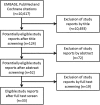Opioid-Induced Constipation and Bowel Dysfunction: A Clinical Guideline
- PMID: 28034973
- PMCID: PMC5914368
- DOI: 10.1093/pm/pnw255
Opioid-Induced Constipation and Bowel Dysfunction: A Clinical Guideline
Abstract
Objective: To formulate timely evidence-based guidelines for the management of opioid-induced bowel dysfunction.
Setting: Constipation is a major untoward effect of opioids. Increasing prescription of opioids has correlated to increased incidence of opioid-induced constipation. However, the inhibitory effects of opioids are not confined to the colon, but also affect higher segments of the gastrointestinal tract, leading to the coining of the term "opioid-induced bowel dysfunction."
Methods: A literature search was conducted using Medline, EMBASE, and EMBASE Classic, and the Cochrane Central Register of Controlled Trials. Predefined search terms and inclusion/exclusion criteria were used to identify and categorize relevant papers. A series of statements were formulated and justified by a comment, then labeled with the degree of agreement and their level of evidence as judged by the Strength of Recommendation Taxonomy (SORT) system.
Results: From a list of 10,832 potentially relevant studies, 33 citations were identified for review. Screening the reference lists of the pertinent papers identified additional publications. Current definitions, prevalence, and mechanism of opioid-induced bowel dysfunction were reviewed, and a treatment algorithm and statements regarding patient management were developed to provide guidance on clinical best practice in the management of patients with opioid-induced constipation and opioid-induced bowel dysfunction.
Conclusions: In recent years, more insight has been gained in the pathophysiology of this "entity"; new treatment approaches have been developed, but guidelines on clinical best practice are still lacking. Current knowledge is insufficient regarding management of the opioid side effects on the upper gastrointestinal tract, but recommendations can be derived from what we know at present.
Keywords: Constipation; Laxatives; Opioid Antagonists; Opioids; PAMORAs.
© 2016 American Academy of Pain Medicine.
Figures


References
-
- Katz N. The impact of pain management on quality of life. J Pain Symptom Manage 2002;24:S38–47. - PubMed
-
- Trescot AM, Glaser SE, Hansen H, et al.Effectiveness of opioids in the treatment of chronic non-cancer pain. Pain Physician 2008;11:S181–200. - PubMed
-
- Dart RC, Surratt HL, Cicero TJ, et al.Trends in opioid analgesic abuse and mortality in the United States. N Engl J Med 2015;372:241–8. - PubMed
-
- Pappagallo M. Incidence, prevalence, and management of opioid bowel dysfunction. Am J Surg 2001;182:S11–8. - PubMed
-
- McNicol E, Horowicz-Mehler N, Fisk RA, et al.Management of opioid side effects in cancer-related and chronic noncancer pain: A systematic review. J Pain 2003;4:231–56. - PubMed
Publication types
MeSH terms
Substances
LinkOut - more resources
Full Text Sources
Other Literature Sources
Medical

